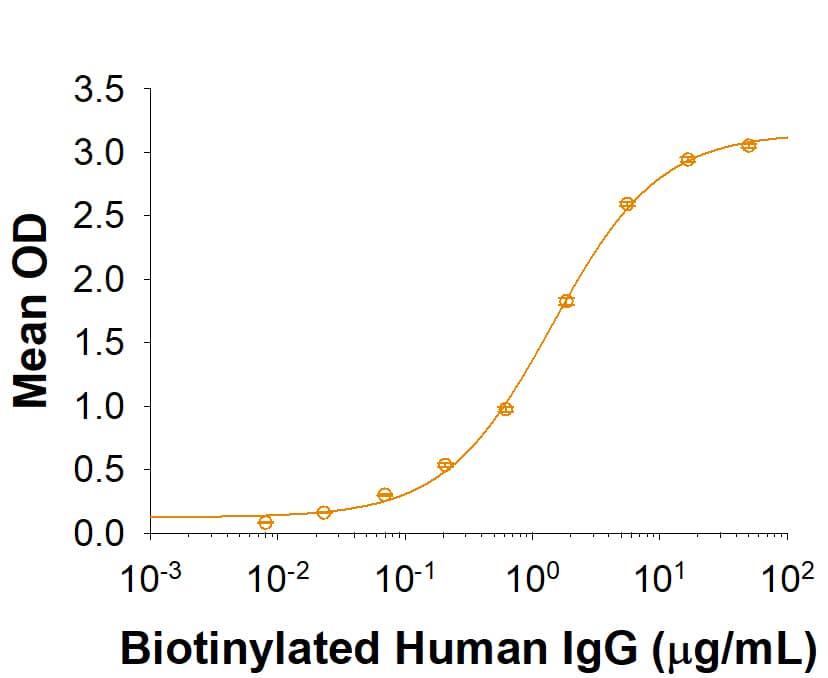Recombinant Human Fc gamma RIIIA/CD16a (V176F) Protein, CF
R&D Systems, part of Bio-Techne | Catalog # 8894-FC
Low-affinity V176F polymorphic variant

Key Product Details
Product Specifications
Source
Human embryonic kidney cell, HEK293-derived human Fc gamma RIIIA/CD16a protein
Gly17-Gln208, with a C-terminal 6-His tag
Gly17-Gln208, with a C-terminal 6-His tag
Purity
>95%, by SDS-PAGE visualized with Silver Staining and quantitative densitometry by Coomassie® Blue Staining.
Endotoxin Level
<0.10 EU per 1 μg of the protein by the LAL method.
N-terminal Sequence Analysis
Gly17 & Met18
Predicted Molecular Mass
23 kDa
SDS-PAGE
43-58 kDa, reducing conditions
Activity
Measured by its binding ability in a functional ELISA.
When Recombinant Human Fc gamma RIIIa/CD16a (V176F) was immobilize on a Ms x PolyHis coated plate, it binds biotinylated Human IgG. The concentration of biotinylated Human IgG that produces 50% of the optimal binding response is approximately 0.5-2.5 μg/mL.
When Recombinant Human Fc gamma RIIIa/CD16a (V176F) was immobilize on a Ms x PolyHis coated plate, it binds biotinylated Human IgG. The concentration of biotinylated Human IgG that produces 50% of the optimal binding response is approximately 0.5-2.5 μg/mL.
Scientific Data Images for Recombinant Human Fc gamma RIIIA/CD16a (V176F) Protein, CF
Recombinant Human Fc gamma RIIIA/CD16a (V176F) Protein Binding Activity
When Recombinant Human Fc gamma RIIIa/CD16a (V176F) was immobilize on a Ms x PolyHis coated plate, it binds biotinylated Human IgG with an ED50 of 0.5-2.5 μg/mL.Formulation, Preparation and Storage
8894-FC
| Formulation | Lyophilized from a 0.2 μm filtered solution in sterile PBS. |
| Reconstitution |
Reconstitute at 100 μg/mL in PBS.
|
| Shipping | The product is shipped at ambient temperature. Upon receipt, store it immediately at the temperature recommended below. |
| Stability & Storage | Use a manual defrost freezer and avoid repeated freeze-thaw cycles.
|
Background: Fc gamma RIIIA/CD16a
References
- Nagelkerke, S.Q. and T.W. Kuijpers (2015) Front. Immunol. 5:674.
- Nimmerjahn, F. and J.V. Ravetch (2006) Immunity 24:19.
- Ravetch, J.V. and B. Perussia (1989) J. Exp. Med. 170:481.
- Scallon, B.J. et al. (1989) Proc. Natl. Acad. Sci. USA 86:5079.
- Wu, J. et al. (1997) J. Clin. Invest. 100:1059.
- Dall’Ozzo, S. et al. (2004) Cancer Res. 64:4664.
- Kim, M.-K. et al. (2003) Blood 101:4479.
- Lanier, L.L. et al. (1989) Nature 342:803.
- Edberg, J.C. and R.P. Kimberley (1997) J. Immunol. 159:3849.
- Li, P. et al. (2007) J. Biol. Chem. 282:6210.
- Masuda, M. et al. (2003) J. Rheumatol. 30:1911.
- Masuda, M. et al. (2006) Atherosclerosis 188:377.
- Webster, N.L. et al. (2006) J. Leukoc. Biol. 79:294.
Long Name
Fc gamma Receptor III A
Alternate Names
CD16a, FCGR3A, FcgRIIIA
Gene Symbol
FCGR3A
UniProt
Additional Fc gamma RIIIA/CD16a Products
Product Documents for Recombinant Human Fc gamma RIIIA/CD16a (V176F) Protein, CF
Product Specific Notices for Recombinant Human Fc gamma RIIIA/CD16a (V176F) Protein, CF
For research use only
